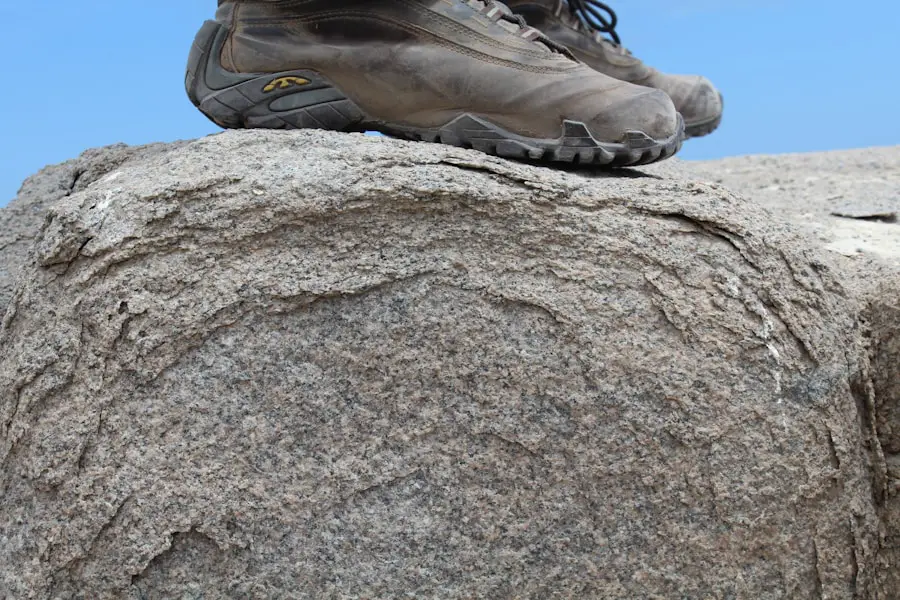When venturing into the great outdoors, the right footwear can make all the difference between a pleasant hike and a hazardous experience. Slip-resistant hiking boots are essential for ensuring safety on various terrains, particularly when conditions are wet or uneven. The importance of these boots cannot be overstated, as they provide the necessary grip to navigate slippery surfaces, such as muddy trails, wet rocks, or icy paths.
A slip can lead to serious injuries, including sprains, fractures, or even more severe accidents that could leave a hiker stranded in a remote area. Therefore, investing in slip-resistant hiking boots is not merely a matter of comfort; it is a crucial aspect of outdoor safety. Moreover, slip-resistant hiking boots are designed with specialized outsoles that enhance traction and stability.
These features are particularly vital when hiking in regions known for their unpredictable weather patterns or challenging landscapes. For instance, trails in mountainous areas can quickly become treacherous after rainfall, with loose gravel and slick surfaces posing significant risks. By wearing boots equipped with slip-resistant technology, hikers can confidently traverse these environments, reducing the likelihood of falls and injuries.
The right footwear not only protects the individual but also allows for a more enjoyable hiking experience, enabling them to focus on the beauty of nature rather than worrying about their footing.
Key Takeaways
- Slip-resistant hiking boots are crucial for safety and stability on the trails.
- Consider factors such as terrain, weather, and personal preferences when choosing the right slip-resistant hiking boots.
- Traction and grip are essential for preventing slips and falls on uneven and slippery surfaces.
- Regularly clean and maintain the traction of your hiking boots to ensure optimal performance.
- Test the slip-resistance of your hiking boots on different surfaces to gauge their effectiveness.
Choosing the Right Slip-Resistant Hiking Boots for Your Needs
Selecting the appropriate slip-resistant hiking boots involves considering several factors tailored to individual needs and hiking conditions. First and foremost, it is essential to assess the type of terrain you will be navigating. For instance, if your hikes will primarily take place on rocky or uneven surfaces, look for boots with a rugged outsole that features deep lugs for enhanced grip.
Conversely, if you plan to hike in wet or muddy conditions, prioritize boots with a rubber compound designed specifically for superior traction on slick surfaces. Another critical aspect to consider is the fit and comfort of the boots. A well-fitted boot should provide adequate support without being too tight or restrictive.
It is advisable to try on hiking boots with the socks you intend to wear during your hikes, as this can significantly affect the fit. Additionally, consider the boot’s weight; lighter options may be preferable for long-distance hikes where fatigue can set in quickly. However, heavier boots often offer more support and durability, which can be beneficial for challenging terrains.
Ultimately, finding a balance between comfort, support, and slip-resistance is key to ensuring an enjoyable hiking experience.
Understanding Traction and Grip

Traction and grip are fundamental concepts when discussing slip-resistant hiking boots. Traction refers to the ability of the boot’s outsole to maintain contact with the ground without slipping, while grip pertains to how well the material of the outsole adheres to various surfaces. The combination of these two elements is crucial for preventing slips and falls during hikes.
Different types of outsoles are engineered for specific conditions; for example, Vibram outsoles are renowned for their durability and grip on both wet and dry surfaces. The design of the outsole plays a significant role in determining traction. Boots with multi-directional lugs provide better grip by allowing for movement in various directions without losing stability.
Additionally, the material composition of the outsole affects its performance; rubber compounds that are softer tend to offer better grip on slick surfaces compared to harder materials. Understanding these nuances can help hikers make informed decisions when selecting their footwear, ensuring they choose boots that will perform well under specific conditions.
Tips for Maintaining the Traction of Your Hiking Boots
| Tip | Description |
|---|---|
| Clean Regularly | Remove dirt and debris to maintain traction |
| Use a Brush | Brush off mud and dirt with a stiff brush |
| Inspect Soles | Check for wear and tear on the sole for optimal grip |
| Store Properly | Avoid leaving boots in direct sunlight or extreme temperatures |
| Replace Worn Outsoles | Replace worn outsoles for better traction |
Maintaining the traction of your hiking boots is essential for ensuring their longevity and effectiveness on slippery trails. One of the most important steps in this maintenance process is regular cleaning. After each hike, especially those involving mud or water, it is crucial to remove dirt and debris from the outsoles.
A soft brush or cloth can be used to scrub away any buildup that may compromise traction. Additionally, allowing the boots to dry naturally after cleaning helps preserve their materials and prevents mold or mildew growth. Another vital aspect of maintenance is inspecting the outsoles for signs of wear and tear.
Over time, the lugs on the outsole can become worn down, reducing their effectiveness in providing grip. If you notice significant wear, it may be time to consider resoling your boots or investing in a new pair altogether. Furthermore, applying a waterproofing treatment can help maintain the integrity of the materials used in your boots, ensuring they remain effective in wet conditions.
By taking these proactive steps, hikers can extend the life of their slip-resistant boots while ensuring optimal performance on slippery trails.
How to Test the Slip-Resistance of Your Hiking Boots
Testing the slip-resistance of hiking boots before embarking on a hike can provide valuable insights into their performance capabilities. One effective method involves conducting a simple slip test on various surfaces at home or in a controlled environment. For instance, you can try walking on different materials such as tile, wood, or wet grass to gauge how well your boots grip these surfaces.
Pay attention to how easily you can maintain your balance and whether you feel secure while walking. Another approach is to assess the boot’s performance on inclines or declines. Find a slope that mimics the conditions you might encounter on a hike and walk up and down it while paying close attention to how your boots respond.
If you feel confident and stable during this test, it is likely that your boots will perform well on actual trails. Additionally, seeking feedback from fellow hikers or reading reviews online can provide further insights into how specific models perform in real-world conditions. This comprehensive testing approach ensures that you select footwear that meets your slip-resistance needs.
Safety Precautions to Take When Hiking on Slippery Trails

Assessing Trail Conditions
Before setting out, it is essential to assess trail conditions. If rain has recently fallen or if snow is melting, consider postponing your hike until conditions improve.
Staying Safe on the Trail
Additionally, always inform someone about your hiking plans and expected return time; this precaution ensures that help can be summoned if needed. While on the trail, awareness of your surroundings is crucial. Pay attention to changes in terrain and be cautious when navigating steep or uneven sections.
Tips for Navigating Slippery Areas
Using trekking poles can provide additional stability and support while traversing slippery areas. Furthermore, adopting a slower pace allows for better control over your movements and reduces the likelihood of slips. If you encounter particularly treacherous sections, consider taking alternative routes or using established footpaths that may offer better traction.
The Benefits of Investing in High-Quality Slip-Resistant Hiking Boots
Investing in high-quality slip-resistant hiking boots offers numerous advantages that extend beyond mere safety considerations. One significant benefit is durability; well-constructed boots are designed to withstand harsh outdoor conditions and frequent use without compromising performance. High-quality materials not only enhance traction but also provide waterproofing features that keep feet dry during wet hikes.
Additionally, premium hiking boots often come equipped with advanced technologies that improve comfort and support. Features such as cushioned insoles and ankle support systems contribute to overall foot health during long hikes, reducing fatigue and discomfort. Furthermore, high-quality brands typically offer better warranties and customer service support, ensuring that any issues with your footwear can be addressed promptly.
By investing in superior slip-resistant hiking boots, hikers can enjoy enhanced safety and comfort while exploring diverse terrains.
Other Safety Gear to Consider for Hiking on Slippery Trails
While slip-resistant hiking boots are paramount for safety on slippery trails, other gear should also be considered to enhance overall protection during hikes. One essential item is a good pair of trekking poles; these provide additional stability and balance while navigating uneven terrain or steep inclines. Trekking poles can help distribute weight more evenly across your body and reduce strain on your knees during descents.
In addition to trekking poles, wearing appropriate clothing is vital for maintaining comfort and safety during hikes. Moisture-wicking fabrics help regulate body temperature while keeping sweat at bay, which is particularly important when hiking in humid conditions. Layering clothing allows hikers to adapt to changing weather conditions effectively; this flexibility ensures that you remain comfortable regardless of temperature fluctuations throughout your hike.
Furthermore, carrying a first aid kit equipped with essentials such as band-aids, antiseptic wipes, and pain relievers can be invaluable in case of minor injuries or accidents on the trail. A reliable navigation tool—whether it be a GPS device or a traditional map—can also enhance safety by helping hikers stay oriented in unfamiliar areas. By considering these additional safety gear options alongside slip-resistant hiking boots, outdoor enthusiasts can significantly reduce risks associated with slippery trails while enjoying their adventures in nature.
If you are looking for hiking boots that are slip-resistant, you may want to check out this article on the best time to travel to New Zealand: a seasonal guide. This article provides valuable information on when to visit New Zealand based on the weather and outdoor activities available, which can help you choose the right hiking boots for your trip.
FAQs
What are slip-resistant hiking boots?
Slip-resistant hiking boots are designed with outsoles that provide better traction and grip on various surfaces, reducing the risk of slipping and falling while hiking on different terrains.
How do slip-resistant hiking boots work?
Slip-resistant hiking boots typically feature specialized rubber compounds and tread patterns that increase friction and provide better grip on wet, slippery, or uneven surfaces. This helps hikers maintain stability and balance while navigating challenging terrain.
What are the benefits of slip-resistant hiking boots?
The main benefit of slip-resistant hiking boots is the reduced risk of slipping and falling while hiking. These boots provide better traction and stability, allowing hikers to confidently tackle different types of terrain without worrying about potential slips or accidents.
Are all hiking boots slip-resistant?
Not all hiking boots are slip-resistant. While many hiking boots are designed with some level of traction and grip, not all of them are specifically labeled as slip-resistant. It’s important to look for boots that are explicitly marketed as slip-resistant if this feature is a priority for you.
How can I tell if hiking boots are slip-resistant?
Hiking boots that are slip-resistant are typically labeled as such by the manufacturer. Look for specific mentions of slip resistance in the product description or on the boot’s packaging. Additionally, you can check for features such as specialized rubber compounds and aggressive tread patterns, which are common indicators of slip-resistant footwear.
